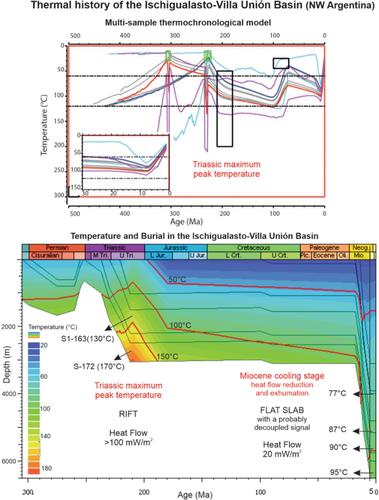当前位置:
X-MOL 学术
›
Basin Res.
›
论文详情
Our official English website, www.x-mol.net, welcomes your feedback! (Note: you will need to create a separate account there.)
Thermochronometry unveils ancient thermal regimes in the NW Pampean Ranges, Argentina: From Mesozoic rifting to Miocene flat-slab subduction
Basin Research ( IF 3.2 ) Pub Date : 2022-07-14 , DOI: 10.1111/bre.12693 Miguel Ezpeleta 1, 2 , Mauricio Parra 3 , Gilda Collo 1, 4 , Cecilia Wunderlin 1 , Angeles G. Borrego 5 , Edward R. Sobel 6 , Johannes Glodny 7
Basin Research ( IF 3.2 ) Pub Date : 2022-07-14 , DOI: 10.1111/bre.12693 Miguel Ezpeleta 1, 2 , Mauricio Parra 3 , Gilda Collo 1, 4 , Cecilia Wunderlin 1 , Angeles G. Borrego 5 , Edward R. Sobel 6 , Johannes Glodny 7
Affiliation

|
Reconstructing thermal histories in thrust belts is commonly used to infer the age and rates of thrusting and hence the driving mechanisms of orogenesis. In areas where ancient basins have been incorporated into the orogenic wedge, a quantitative reconstruction of the thermal history helps distinguish among potential mechanisms responsible for heating events. We present such a reconstruction for the Ischigualasto-Villa Unión basin in the western Pampean Ranges of Argentina, where Triassic rifting and late Cretaceous-Cenozoic retroarc foreland basin development has been widely documented, including Miocene flat-slab subduction. We report results of organic and inorganic thermal indicators acquired along three stratigraphic sections, including vitrinite reflectance and X-ray diffractometry in claystones and new thermochronological [(apatite fission-track and apatite and zircon [U-Th]/He)] analyses. Despite up to 5 km-thick Cenozoic overburden and unlike previously thought, the thermal peak in the basin is not due to Cenozoic burial but occurred in the Triassic, associated with a high heat flow of up to 90 mWm−2 and <2 km of burial, which heated the base of the Triassic strata to ~160°C. Following exhumation, attested by the development of an unconformity between the Triassic and Late-Cretaceous–Cenozoic sequences, Cenozoic re-burial increased the temperature to ~110°C at the base of the Triassic section and only ~50°C 7 km upsection, suggesting a dramatic decrease in the thermal gradient. The onset of Cenozoic cooling occurred at ~10−8 Ma, concomitant with sediment accumulation and thus preceding the latest Miocene onset of thrusting that has been independently documented by stratigraphic–cross-cutting relationships. We argue that the onset of cooling is associated with lithospheric refrigeration following establishment of flat-slab subduction, leading to the eastward displacement of the asthenospheric wedge beneath the South American plate. Our study places time and temperature constraints on flat-slab cooling that calls for a careful interpretation of exhumation signals in thrustbelts inferred from thermochronology only.
中文翻译:

热计时法揭示了阿根廷 NW Pampean 山脉的古代热状态:从中生代裂谷到中新世平板俯冲
重建冲断带中的热历史通常用于推断冲断的年龄和速率,从而推断造山运动的驱动机制。在古代盆地被纳入造山楔的地区,热历史的定量重建有助于区分导致加热事件的潜在机制。我们展示了阿根廷西部潘比亚山脉 Ischigualasto-Villa Unión 盆地的重建,那里的三叠纪裂谷和晚白垩世-新生代弧后前陆盆地发育已被广泛记录,包括中新世平板俯冲。我们报告了沿三个地层剖面获得的有机和无机热指标的结果,包括粘土岩中的镜质体反射率和 X 射线衍射以及新的热年代学 [(磷灰石裂变径迹和磷灰石和锆石 [U-Th]/He)] 分析。尽管新生代覆盖层厚度高达 5 公里,而且与之前认为的不同,盆地中的热峰值不是由于新生代埋藏而是发生在三叠纪,与高达 90 mWm 的高热流相关−2和 <2 公里的埋藏,将三叠纪地层底部加热至约 160°C。挖掘之后,通过三叠纪和晚白垩世-新生代序列之间不整合的发展证明,新生代的重新埋葬将三叠纪底部的温度提高到~110°C,并且只有~50°C 7 km upsection,表明热梯度急剧下降。新生代冷却的开始发生在~10 -8 Ma,伴随着沉积物的积累,因此在最近的中新世逆冲开始之前,这已被地层 - 横切关系独立记录。我们认为,冷却的开始与平板俯冲建立后的岩石圈制冷有关,导致南美板块下方的软流圈楔向东位移。我们的研究对平板冷却设置了时间和温度限制,这要求仔细解释仅从热年代学推断的推力带中的折返信号。
更新日期:2022-07-14
中文翻译:

热计时法揭示了阿根廷 NW Pampean 山脉的古代热状态:从中生代裂谷到中新世平板俯冲
重建冲断带中的热历史通常用于推断冲断的年龄和速率,从而推断造山运动的驱动机制。在古代盆地被纳入造山楔的地区,热历史的定量重建有助于区分导致加热事件的潜在机制。我们展示了阿根廷西部潘比亚山脉 Ischigualasto-Villa Unión 盆地的重建,那里的三叠纪裂谷和晚白垩世-新生代弧后前陆盆地发育已被广泛记录,包括中新世平板俯冲。我们报告了沿三个地层剖面获得的有机和无机热指标的结果,包括粘土岩中的镜质体反射率和 X 射线衍射以及新的热年代学 [(磷灰石裂变径迹和磷灰石和锆石 [U-Th]/He)] 分析。尽管新生代覆盖层厚度高达 5 公里,而且与之前认为的不同,盆地中的热峰值不是由于新生代埋藏而是发生在三叠纪,与高达 90 mWm 的高热流相关−2和 <2 公里的埋藏,将三叠纪地层底部加热至约 160°C。挖掘之后,通过三叠纪和晚白垩世-新生代序列之间不整合的发展证明,新生代的重新埋葬将三叠纪底部的温度提高到~110°C,并且只有~50°C 7 km upsection,表明热梯度急剧下降。新生代冷却的开始发生在~10 -8 Ma,伴随着沉积物的积累,因此在最近的中新世逆冲开始之前,这已被地层 - 横切关系独立记录。我们认为,冷却的开始与平板俯冲建立后的岩石圈制冷有关,导致南美板块下方的软流圈楔向东位移。我们的研究对平板冷却设置了时间和温度限制,这要求仔细解释仅从热年代学推断的推力带中的折返信号。



























 京公网安备 11010802027423号
京公网安备 11010802027423号